It so happens that every tomato variety of the seven I’m growing this summer has done well and tastes good enough to justify planting again next year. They’re all a little different, and I’d be selfish not to tell you about them.
Small-fruited types
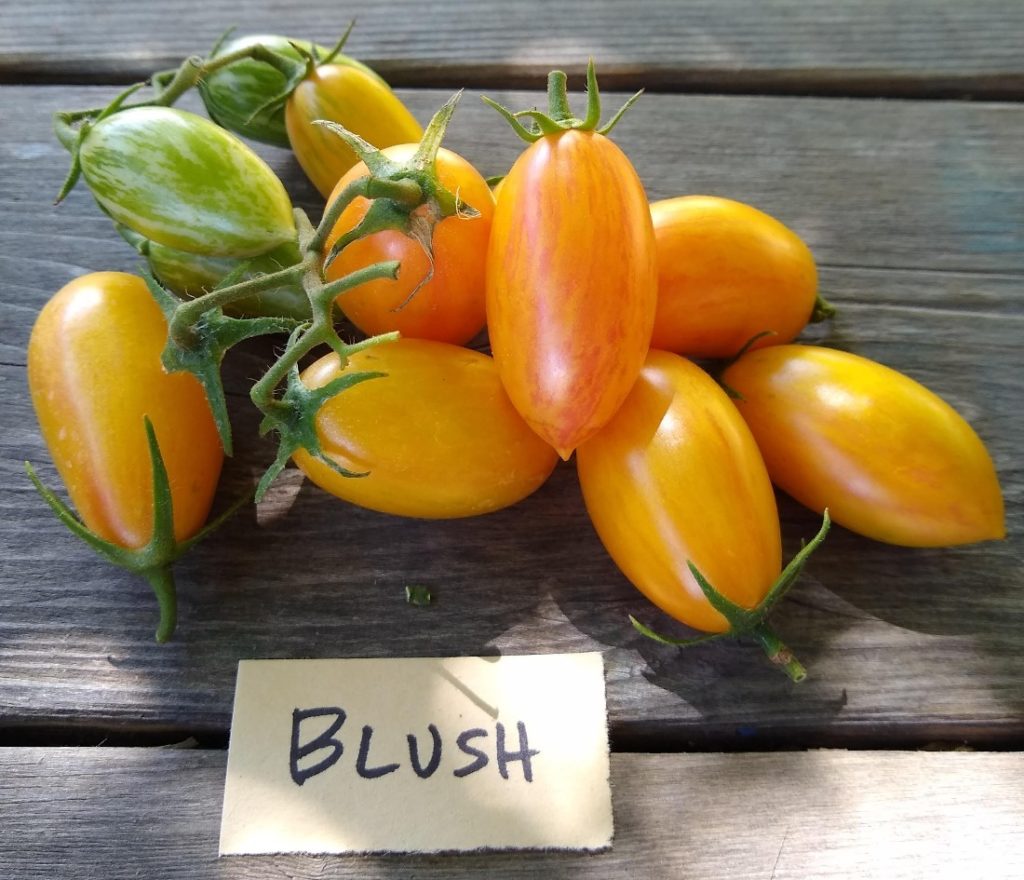
Blush
In our family, the tomato lover is my three-year old son, and a couple weeks ago he made a lunch request: “Can you pick some of my favorite tomatoes? You know, the ones that are like (stretches his hands apart), and are pointy.”
I hadn’t known Blush had become his favorite, but I understood why. They look beautiful with their red streaks, and the taste is fruity but not overly sweet — it still tastes like a tomato, but a wonderfully tropical tomato.
The Blush plant is medium, not as large and rambling as Sungold.
(Blush tomato seeds and plants available from Territorial.)
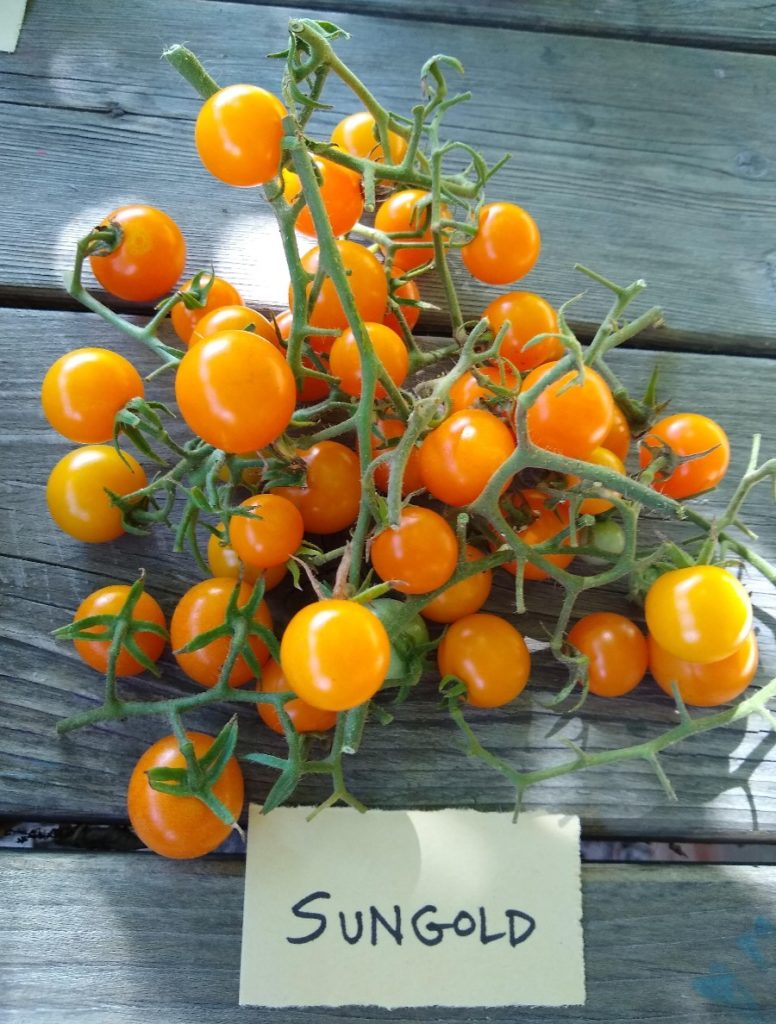
Sungold
It turns out that my three-year old is not a big fan of Sungold, which he finds too sweet. I’ve never tasted a sweeter tomato than Sungold — although I must note that Sungolds grown close to the beach never taste quite as sweet as in my current, inland garden. (That can be a good or bad thing, depending on your taste preference.)
Sungold tomatoes are cherry size, and the plant produces oodles of fruit. It is one of a few varieties that we grow almost every summer.
Sungolds are best eaten right there beside the plant in the garden. If you try to harvest some to give to a friend tomorrow, they will often split unless you harvest them slightly immature and keep the stem attached.
(Sungold tomato seeds and plants available from Territorial.)
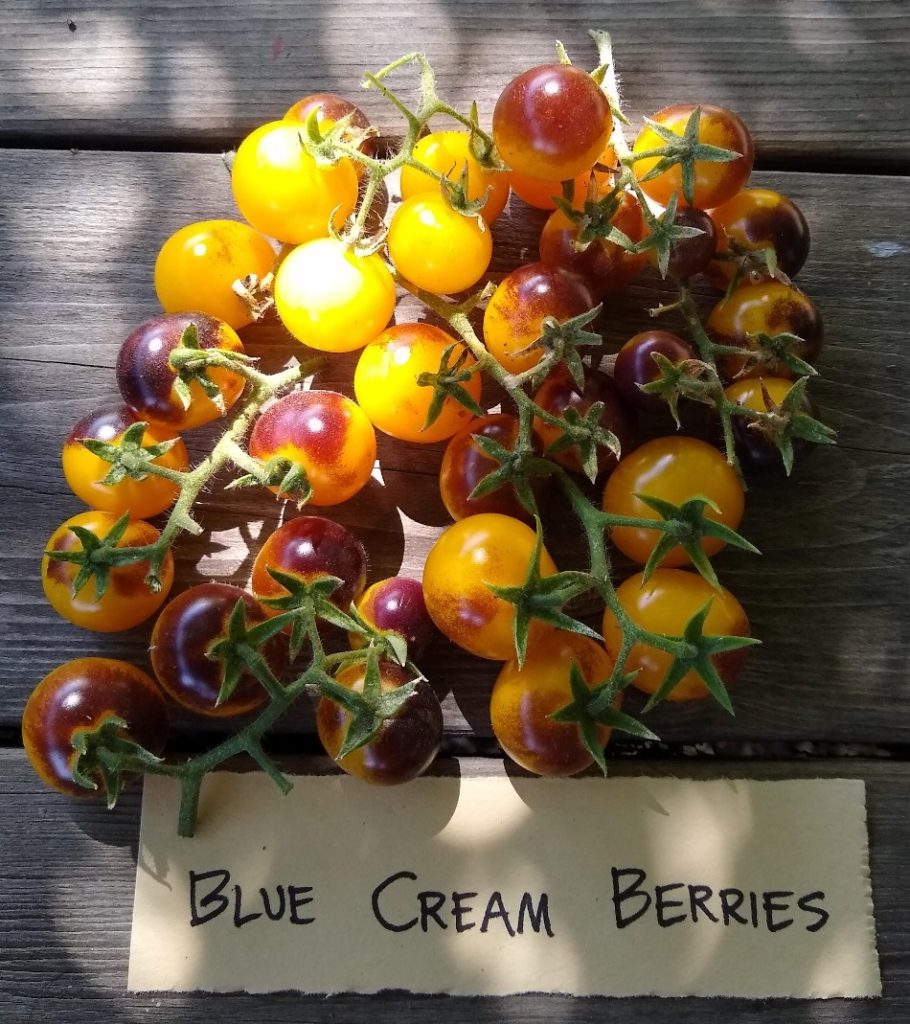
Blue Cream Berries
Blue Cream Berries are a very different cherry tomato compared to Sungold in that they are less sweet and rarely split, even when left on the vine past maturity.
The vine is vigorous like Sungold and extremely fruitful, and the coloring is attractive as it turns from black to indigo and yellow, to mostly yellow when fully mature.
You expect this dazzling color knowing that Blue Cream Berries is a variety developed by Brad Gates or Wild Boar Farms in Northern California. Every tomato variety of Gates that I’ve grown has had impressive skin colors and patterns, if not always equally impressive production or taste. The flavor of Blue Cream Berries is unremarkable yet good; being that the good flavor is wrapped inside brilliant, glowing skin makes it worth growing again.
(Blue Cream Berries tomato seeds available from Baker Creek.)
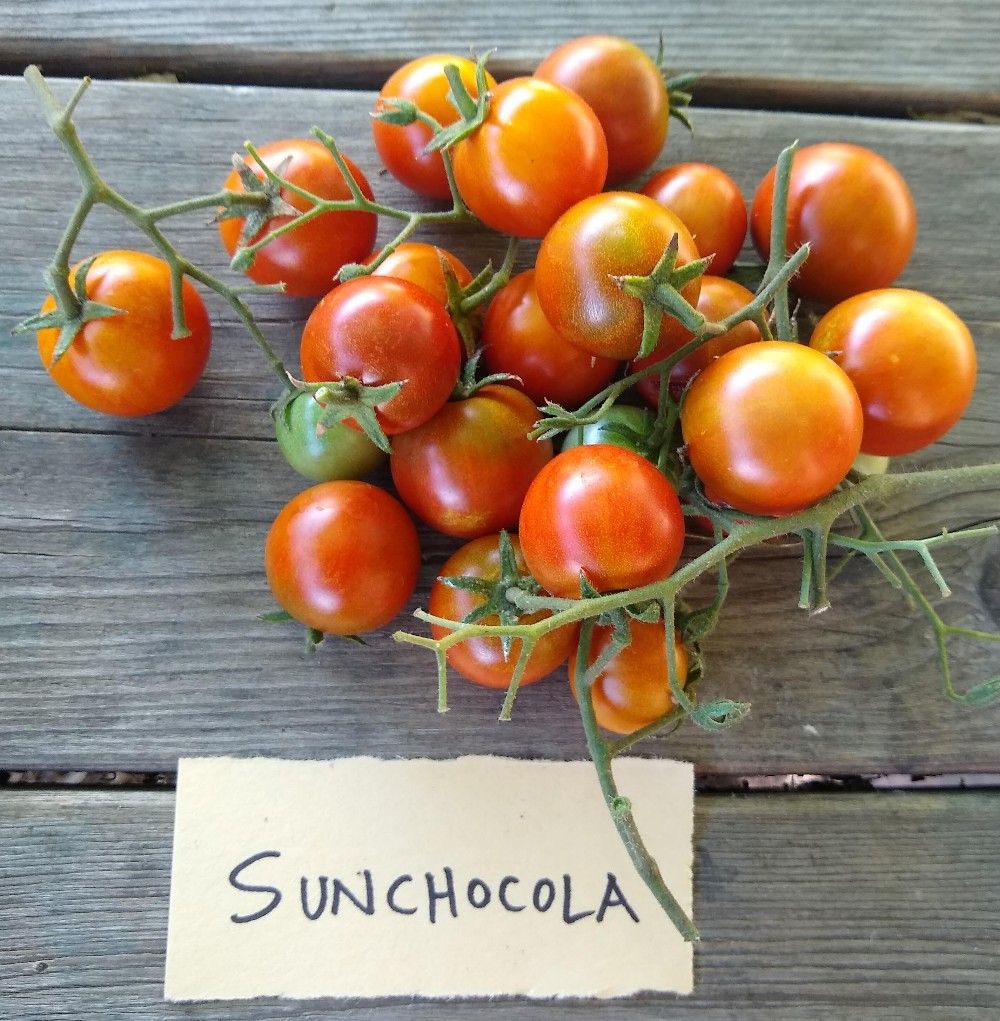
Sunchocola
Of the three cherries I’m growing this year, Sunchocola has the richest flavor. It’s not a looker like Blue Cream Berries, but oh, the flavor. You eat the Blue Cream Berries tomatoes and you say, “Nice tomatoes.” You eat the Sungolds and you say, “Explosively sweet!” Then you eat the Sunchocola and you say, “Wow! That flavor! Wow! What is it?” It’s soft and mellow, not acidic; it’s slightly sweet but doesn’t taste fruity; and there’s something smoky in the background, something pleasantly roasted, just rich.
The size of Sunchocola is slightly big for a cherry, and the color is red burnished with brown, which I suspect influences my perception of its flavor.
(Sunchocola tomato seeds and plants available from Territorial.)
We eat all of the above tomatoes whole, as snacks. Below are three tomatoes that we slice and use in other ways.
Medium-sized types
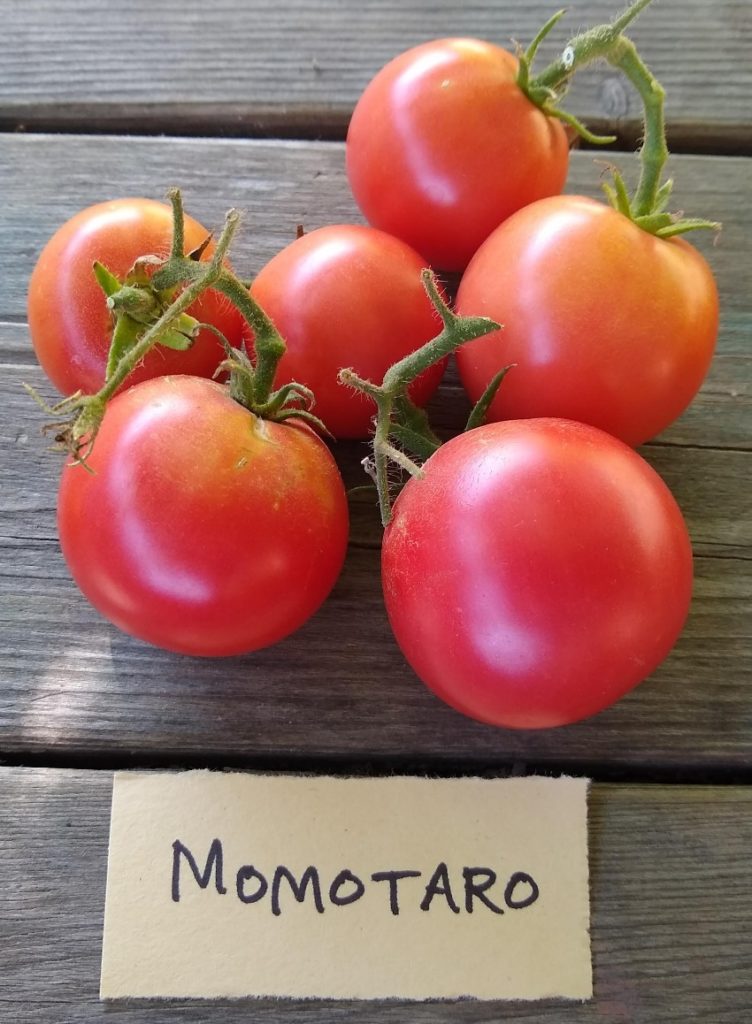
Momotaro
I first tasted Sunchocola in my mother-in-law’s garden in Oregon, and knew I needed to try it in my Southern California yard this year. But her favorite eating tomato has long been Momotaro. It’s all she grows in that tomato category, every summer.
Momotaro was developed in Japan. It only produces acceptably in our yard, not as prolificly as some others. But considering its taste, I forgive it.
Let me come back to Momotaro after looking at the others.

San Marzano
This one’s a classic. It is a “Roma” type, having an elongated shape with a meaty middle. Some call them “plum” tomatoes even though the plums we mostly grow in Southern California are round. It’s the Italian plums that are shaped like San Marzano tomatoes, or is it the other way around?
For our family, the role that San Marzano plays is that of the producer. San Marzano makes tons of fruit. While we eat a few of them fresh, mostly they go straight into freezer bags to be used in the winter for salsas and sauces.
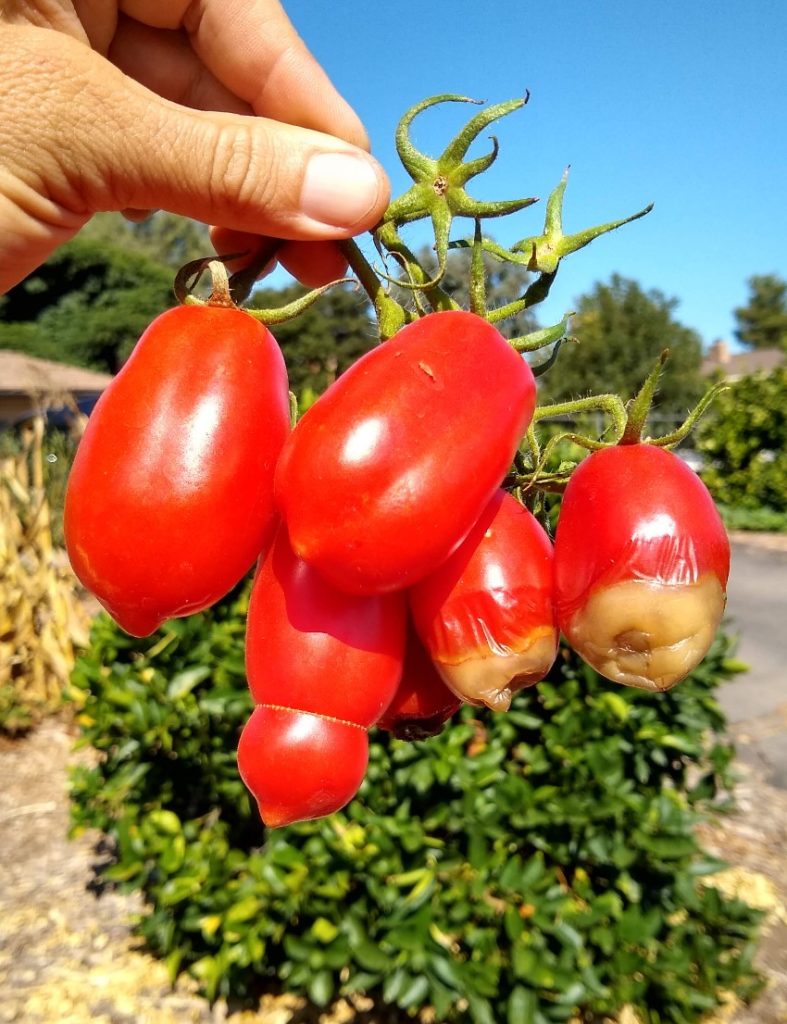
Unfortunately, like other Roma types, San Marzano does get blossom end rot more than average, but since it is so incredibly productive it doesn’t discourage. The color is classic tomato and the flavor is classic tomato.
(San Marzano tomato seeds and plants available from Territorial.)
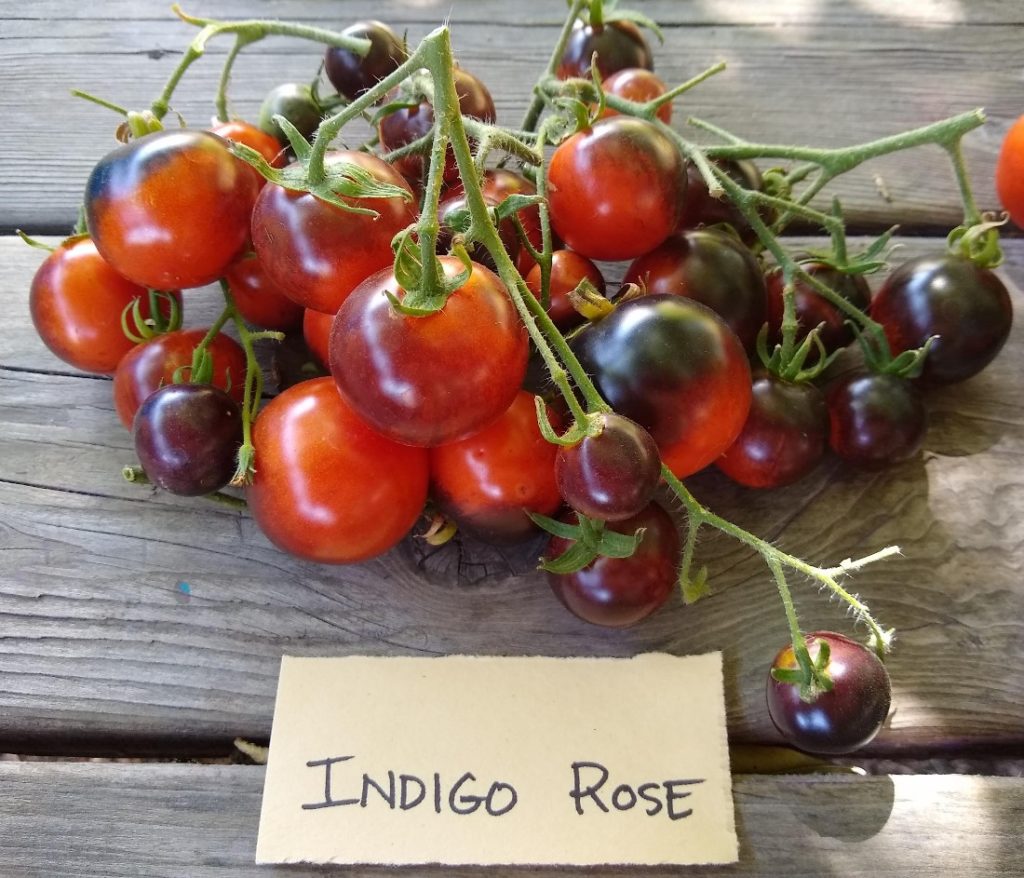
Indigo Rose
Indigo Rose is anything but an old reliable. It was bred relatively recently at Oregon State University. It’s got peculiar coloring. Similar to Blue Cream Berries, it starts out black and then fades as it ripens, but this one ending up black and red, and this one having more remarkable flavor to match its appearance.
As I’ve written before, Indigo Rose is the best tasting indigo tomato that I’ve tasted. It has a pleasing tomato flavor with no bitterness, and it is juicy rather than meaty.
And boy does this puppy put out the fruit. It’s looking a little tired here at the end of August, but the plant has been pumping out tomatoes continuously for a couple months now. The tomatoes vary in size from jawbreaker to just under tennis ball.
(Indigo Rose tomato seeds available from Johnny’s.)
Momotaro, again
So I sliced up these three bigger tomatoes and photographed them side by side.
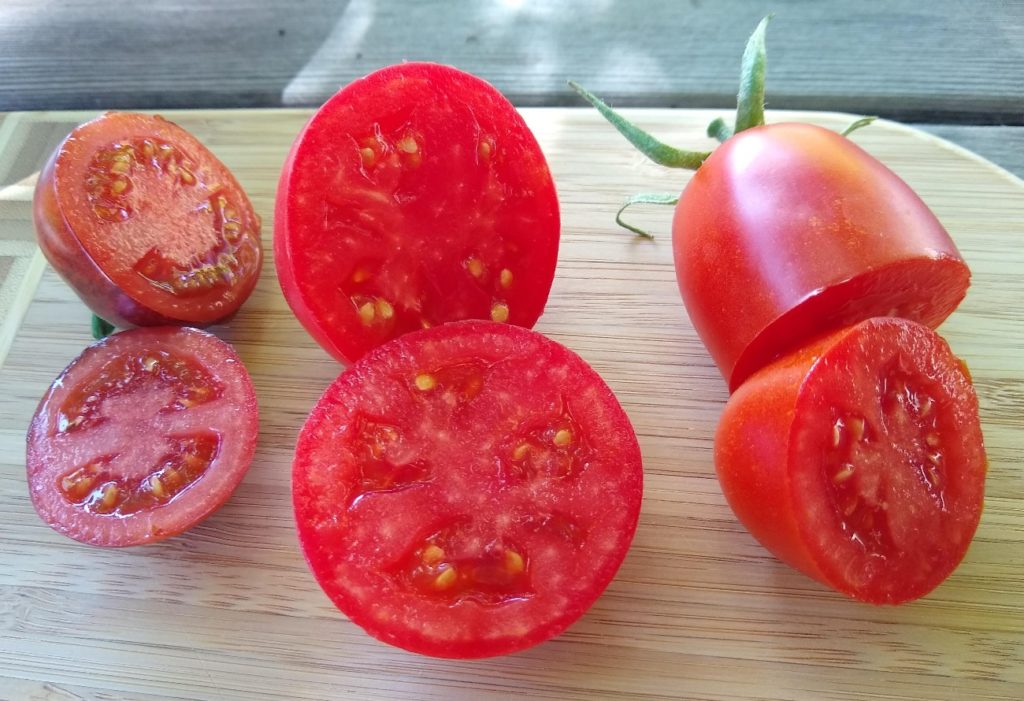
Look at the glow of that Momotaro in the middle! Looks like I doctored the photo.
Inside and out, Momotaro has a deep pink color rather than the classic red of San Marzano. But it is meaty inside like the San Marzano, not so hollow and juicy like the Indigo Rose.
I tasted each, one after the other. Indigo Rose, very pleasing flavor. San Marzano, a little bland, but I knew it would ripen to a fuller, delicious but regular tomato flavor. Momotaro, something special, a dense texture, a mild but somehow superior flavor than the others.
I wondered if it was because I’d grown that Momotaro without irrigation. As I mentioned in a previous post, I grew a few tomato plants without irrigation this summer and was curious to discover whether the fruit would taste richer and more concentrated. So I sliced up a Momotaro from a plant in the garden that had been watered just like my other tomatoes. Nope. Same exact texture and flavor as the unirrigated one. Both superior.
Twenty minutes later, my wife was eating her lunch, which included some of the tomatoes I’d sliced, and she stopped me to say, “That one tomato that’s really red is even better than the others.”
She didn’t know it was Momotaro, but her mother would be proud.
(Momotaro tomato seeds and plants available from Territorial.)
What to do now?
The end of August is too late for planting new tomatoes, in case you wanted to try any of these in your garden. But I’ll set it on my calendar to remind us of this post around New Year’s, when it’s time to order tomato seeds or plants for growing next summer. (I usually start tomato seeds around the end of January and put them into the garden ground starting in mid-April.)
Have any other tomato varieties that you’re definitely going to grow again next year? Please share in the comments. I’ve already been recommended to try Blue Beauty, another Brad Gates / Wild Boar Farms variety, and I’d love to add a few more to the list for next year.
That’s the beauty of tomatoes: there are so many varieties that you can never try them all. At least we can focus on trying the ones that have already proven to grow well somewhere in Southern California.
You might also like to read:
The best way to support tomato plants




I’ve had very good luck with Tiny Tims in the past. This summer was a tomato disappointment for us. We grew some plants we found at the local garden center that were just called “cherry tomatoes” (no further detail), and they did ok and tasted good, but the plants got so rangy that they turned their whole end of the garden into a big mess, and several fell over and broke. Maybe I need to prune them? That should be your next article. 🙂 I also grew some tomatoes that were called Green Zebra, and those just aren’t worth picking. They taste like a big ball of slightly tart mush. Even the dog won’t eat them (and he’s been harvesting my other tomatoes all summer). Next summer I’m going to follow your recommendations and hope for better luck!
Hi Melissa,
I grew Green Zebra once. Once.
I really messed up with supporting and controlling and pruning some of my tomatoes this year too. Some broke the twine I was using to hold them up, one grew 12 feet tall up the side of my orange tree and then toppled over, while a few others are just meandering in the paths of my vegetable garden.
Why is it that we always forget how massive tomato plants can get over the course of our long growing season in Southern California?
I always have a few staples I plant. This next year I’m getting a hold of some Mexican Midget tomato seeds. I’m very excited to grow them next year!
Hi Eric,
Mexico Midget looks like a winner. Thanks for the tip. Looks like Seed Savers Exchange has it.
I found the momotaro on https://www.fedcoseeds.com/seeds/momotaro-slicing-tomato-4241 they say renamed tough boy.And at ebay 25 seeds for under $5.,,
I always grow Betterboy tomatoes. Can you comment on how the Momotaro compares to the Betterboy?
Hi Richard,
I haven’t grown Betterboy for a few years. My recollection is that Betterboy bears better but Momotaro looks and tastes a little more distinctive. That’s just memory speaking, however, so I don’t trust it much.
Thanks Greg, I removed my raised bed garden several years ago for a larger new patio cover. This year we had two cherry tomatoes that volunteered on our steep clay slope. Missing my garden I let them grow on their own. One plant grew to about 8 feet in diameter. The second plant grew to over 9 feet in diameter. I may have given them a few tiny waterings back in June but not a drop since. We have been picking tomatoes and decent quantities since late June. I continue to be amazed that they were able to grow without any water. I sincerely appreciate your tomatoes reviews and will be growing several next year.
We too grew the blush tomato this summer and it was sweet with a rich tomato flavor. I’ve saved seed from these for next summers garden. Your reviews of the varieties you planted are very helpful!
Picked up a few indigo kumquats (a cherry tomato type) starts at Mission Hills Nursery and they were the stars this year. Very prolific and beautiful. Flavor was very good. I thought flavor was best picked slightly underripe. The toddlers LOVED to pick and eat them off the vine.
It wasn’t the best tomato year for us. I planted too early and my plants got hit with something, early blight I think, from the very wet and muggy early summer we had. Looking forward to trying some of these varieties next year!
Hi Patty,
I’ve been curious about Indigo Kumquat. I really like the shape. Thanks for the info. I’ll try it next year for sure.
We are further Inland in Riverside, and the last 3 years my tomatoes have gotten overrun with mites in late July/early August, so that by mid-August they are engulfed and inedible. I have preferred to not to use any insecticides, which works fine for the aphids on my kale, which seem to establish a balance with lady bugs, but the mites are a category all by themselves. I wonder if there are varieties that are less susceptible?
I usually grow Best Boy for slicing and salsa, then for cherry tomatoes, I like Super Sweet 100. This year I tried ones I used to grow when I lived in Colorado. Rutgers is a medium size slicer and Gardener’s Delight is a cherry. I have to say I’ve been a little disappointed.
First, the skin of the cherry tomato is thicker than I’m used to and second, the shoulder area stays yellow even after maturity. The Rutgers also had tough yellow shoulders. Do you think it is sunburn? I noticed my daughter had a tub of cherry tomatoes from the store and they had had yellow tops too. What’s with that?
I’m looking forward to next tomato season though. I’m going to try Sungolds, Sunchocola, and Momotaro. I like seeing the results you got. I hope my soil is adequate. I switched from Mountain Mushroom compost to Recipe 420 this year. If any one has any recommendations, I would greatly appreciate it.
From San Marcos lake area, thank you Greg for sharing your gardening knowledge.
Hi Bill,
Thanks for the variety info. The yellow shoulders and tough skin could be a varietal trait that is constant, but possibly it is related to the weather. From growing some of the same varieties year after year in the same garden, I’ve observed that the same variety rarely looks and tastes and yields exactly the same in back to back years, so I figure it’s weather related.
For example, our Sungolds had tough skin one year. This year they don’t.
Sunburn does appear as yellowed skin, but rather than being tough, I’ve always found it to become a soft and sometimes sunken spot on the tomato. And the sunburn is rarely on the shoulders in general but usually mostly on the western side of the tomato. That’s how it is in my yard, anyway.
Thanks for the tomato performance reviews. It’s always good to find out how others experiences with various varieties measure up here in SoCal. I haven’t been inspired to plant a cherry type tomato in years, but I’ll be trying Sunchocola this year, primarily for my granddaughters snacking pleasure. Momotaro will be on the list for trial next year… looks promising.
My wife favors grape type tomatoes and I have tested just about every variety available. There is no contest,… here anyway. JULIET is hands down the most vigorous and productive grape type tomato. So vigorous that I am hoping someone will develop a bush habit version. Juliet consistently grows up my 8 foot tall concrete mesh cages and back down to the ground on the outside… and yes I do prune but it can be hard to keep up. Fruit size can approach 50% of normal paste type tomatoes and the flavor and texure is quite similar. They also hold a long time off the plant. My granddaughters love them as a snacking tomato also, but I think they will end up preferring your juicier cherry tomato recommendation.
Thanks for that, David. It so happens that I’ve got a Juliet plant in the ground this year. I haven’t grown Juliet for a handful of years but I love the variety too. As you said, it’s very productive and vigorous. I also find it versatile because of its size. You can slice it up in a sandwich yet it’s still small enough to be a good snack. Can’t wait to see how it does this year.
Hi Greg, I’m growing Momotaro for the first time. The first fruit I picked wasn’t red inside like yours. It tasted “okay”. Now after seeing your pics, I wonder if I picked it at the right time. I waited for it to get dark orange red color – was this too early? too late? thanks! Lyn
Hi Lyn,
I was just thinking about how I don’t have any Momotaro plants in the yard this summer. I ran out of seed and failed to order more. Now I regret it.
It can be hard to get the harvesting right on the first few tomatoes of the summer, especially of a new variety. As long as you pick the Momotaros after they already have orange/red color on their skin, then the flavor should be there if you let them ripen to a fully pink/red skin on the kitchen counter. So the important thing is not so much when to harvest but when to slice it open.
Also, I find that often the early round of tomatoes doesn’t have quite as much flavor as later rounds. It might be that the tomatoes that develop in a little more heat will have improved flavor. The weather this June has been very mild.
Let me know. I hope you get some Momotaros soon that are way more than just “okay.”
“So the important thing is not so much when to harvest but when to slice it open.” I’m a newbie at growing tomatoes so this is a great hint. I have a few that are ready to test out. Thanks!
Update to Momotaro – well. I guess I’m just not a Momotaro fan. I tried them at different stages – early peachy color to late ripened redness. And they were again, “okay”. I’m in San Diego, near the coast, wonder if that changes the way things taste?
On a different note, I’m also growing Paul Robeson tomatoes. They are beauties – but to me they were bland and soft. Did not like at all – UNTIL I turned them into tomato soup. OMG!!- in soup form they blossomed. Just added garlic, onions and a few herbs from the garden and WOW. No sugar or heavy cream needed. Maybe the same could happen with the Momos. 😉
Hi Lyn,
Thanks for the update. Maybe Momotaros just aren’t your cup of tea. It is possible that they develop better flavor here in Ramona than where you are though. I used to live and garden near the zoo and my tomatoes were good, but I have noticed that they do taste even more flavorful here where it’s hotter and sunnier. My old neighbor from there comes to visit in the summers and loves to pick from our Sungold tomato plants because she says they taste better than hers.
Hey do you know of local places to buy tomato plants? from backyard growers?
Hi Jill,
You mean tomato plants grown in Southern California?
I’m really excited to find your post, Greg, as I’ve just relocated to Southern California from Belgium. I had to leave behind my gorgeous Oxheart tomato plants that I’ve been babying since they sprouted in late January. I grew them last year for the first time and fell in love. They have a lovely tangy sweet “true “ tomato flavor. My mouth waters just thinking about them. I’m hoping that they will do as well here as they did in Belgium. We had a very hot, dry summer there last year, and I was gone for most of it, but they managed to survive and produce without my help. Have you ever tried this variety? I’m posting a link that shows the shape and color (not because I know anything about this seed vendor).
https://www.edenbrothers.com/store/pink-oxheart-tomato-seeds.html?gclid=EAIaIQobChMIubzn49Sx8gIVKz2tBh3VjgCBEAQYAyABEgI1OvD_BwE
Hi Loretta,
Welcome to Southern California. Must be so different from gardening in Belgium. I’ve never tried Oxheart Pink. I’ll put it on my list for next summer — thanks for the suggestion.
Hi Greg: Love your newsletters a lot !!! This year purchased some Sunchocola and Momotaro. They arrived late (May 22) due to Covid-19 complications at Territorial Seed. Planted near May end, began to harvest Sept 4~. The Momotaro’s were great. I was disappointed with the Sunchocola as they were quite tart/almost bitter. The fruit was very full sized and nice. I contacted Territorial and they suggested to reduce fertilizer which I did (SMG 18-18-21). Fruit flavor improved but still too tart, not sweet. Not sure if the late planting had an effect or more so the fertilizer, however the Momotaro fertilized the same was sweet and awesome. May try Indigo Rose next year. Live in Oceanside, CA. Any comments Greg? Thank you as always
Hi Joseph,
I’ve also had variability in Sunchocola. The first time I ate them from a plant up in Oregon they were amazing and had no tartness. When I grew them last summer, they had some tartness but I still enjoyed them, especially those I let hang on the plant longer. My wife, however, didn’t care for them and asked that I not bother growing them again. So this year I didn’t grow them.
Mine were grown in less fertility than yours, I would guess. I only use moderate amounts of compost for all of my vegetables. I never considered that would have much impact on the taste of them because I’ve grown tomatoes in unamended parts of my yard also but never noticed a taste difference.
Hi Greg,
Thanks for your posts. Enjoyed the post on staking as I have a smallish yard full of raised beds which complicates things.
Your list of tomato reviews was also great as there are so many to choose from, it’s good to get recommendations. However, I live in Australia and the ones I really wanted to try, Momataro and Sunchocola don’t seem to be available here or maybe they are under different names.
Best
David
The same here for Portugal; no Momotaro / Though Boy seeds available.
Does anybody know a source for that seeds in Europe?
Thanks, Vasco
Is there one you would pick for sauces – spaghetti and pizza sauce? I’m not a fan of snacking on tomatoes or raw/sliced in sandwiches. But looking to try growing one to start making my own sauces.
Hi Greg
Earlier this year you said that you try some Heirlooms in containers. What are the results and what are the names of the plants? Also, do feel that pruning at lower levels lower helps their growth?
Bob
Hi Bob,
I was going to grow some heirloom tomatoes in containers because of the root-knot nematode infestation in my vegetable garden soil, but I found space for them in a new area of dirt instead. So right now I’ve just got two non-hybrid tomatoes in the ground in the new area: Kellogg’s Breakfast and Berkeley Tie Dye. Both are growing great and have many green tomatoes on them.
Because I’m growing them inside large cages of concrete reinforcement wire, I haven’t clipped off lower stems on these plants. Usually, I do no pruning on tomatoes that I support with these cages.
But I do prune off side stems (axillary “suckers”) below about one foot on tomatoes that I support with stakes and string. I do this so I can get all of the vines inside the lowest strings; otherwise, they bush out down low and escape from the strings. I haven’t noticed that this pruning helps the plants’ growth in any other way though.
How are your tomatoes this year? Which varieties are doing best?
Hi Greg: Cant wait for your 2024 Tomato Yard Post similar to this one. I’m still undecided on all but planning on Momotaro x 2 ( 1 Japanese Hybrid, other domestic), Sweet 100, Black Cherry(cherry), Sungold on May-June plant, and maybe Celebrity or San Diego but reviews seem mixed. I want to find a plant/fruit size similar to the Momotaro which is my favorite size/taste. Any suggestions for the medium size fruit tomato variety? Or do I have to wait until you publish ! Thanks for ALL your great Garden Posts. I love the 2024 calendar.